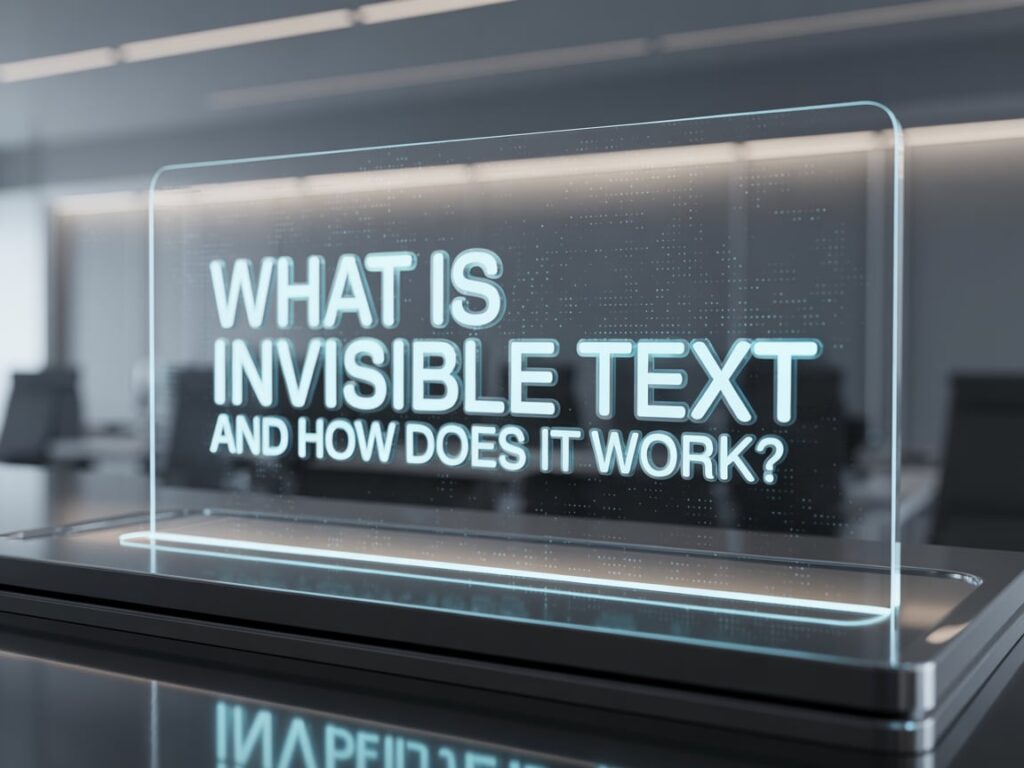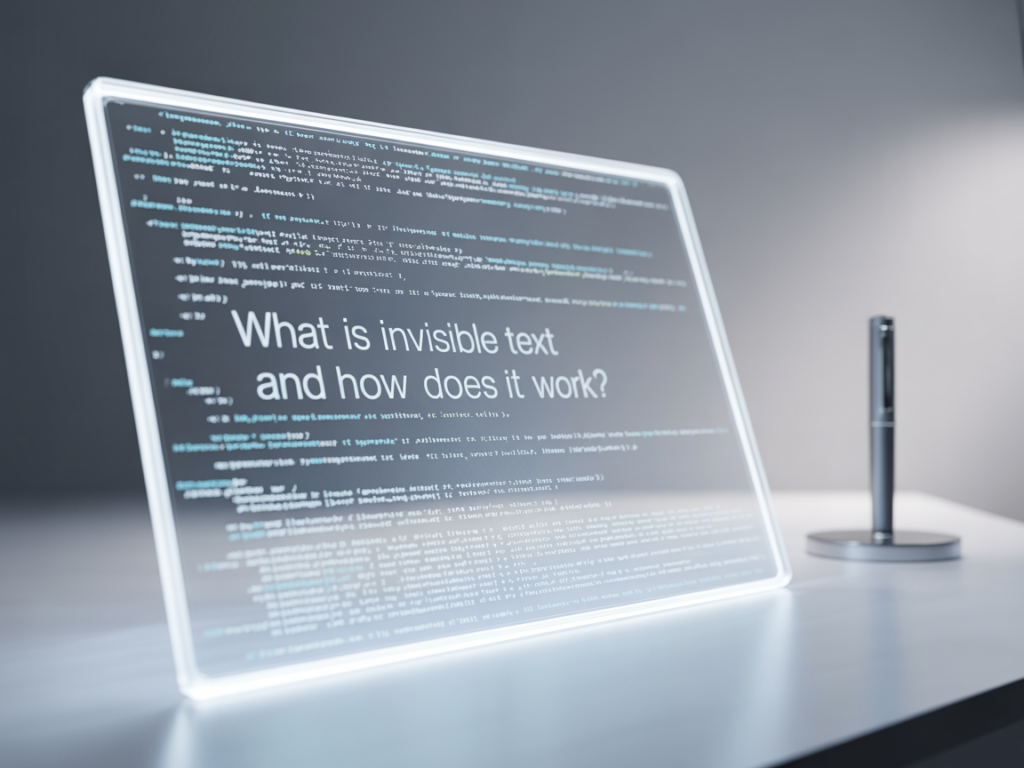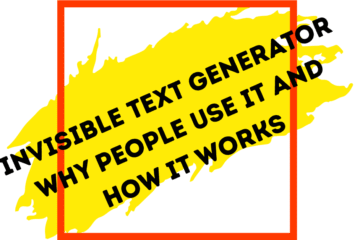Invisible text sounds like something out of a spy movie—but it’s very real and surprisingly common. Whether you’re exploring creative tricks on social media, writing secret notes, or even optimizing SEO strategies, invisible text plays a part. As a digital marketing manager with over a decade of hands-on experience, I’ve seen how powerful this tiny piece of tech can be when used the right way—and how dangerous it becomes when misused. Let’s break it down in simple terms so even an 8th grader can understand it, but also from the professional lens of someone who’s used these tactics in the real world.
What Is Invisible Text?
Invisible text is text that exists in a document or web page but can’t be seen by human eyes. This happens because the characters used don’t show up visually even though they’re technically “there.” You can copy it, paste it, and even search it—but you can’t see it.
This text is often made using Unicode characters like zero-width space (ZWSP), zero-width non-joiner (ZWNJ), and other similar characters. They are called “zero-width” because they don’t take up any space on your screen.
How Does Zero-Width Space Work?
Let’s take the zero-width space, which is officially called U+200B in Unicode. It’s literally an invisible character. You can insert it between letters, words, or even emojis without changing how the text looks. But behind the scenes, your computer or browser knows it’s there.
I once used zero-width characters to hide clues in a gamified email campaign. The audience had no idea the message had hidden instructions—until they copied and pasted it somewhere else.
Here’s a quick example:
| Text You See | Text With Zero-Width Space | Result |
| HelloWorld | HelloWorld | Looks same, but has invisible characters |
This trick can be used for:
- Bypassing filters
- Sending secret messages
- Manipulating search engine results (though this is unethical and not recommended)
Why People Use Invisible Text
Hiding Messages for Fun or Security
People use invisible text for online games, to hide Easter eggs, or for private communication. For example, in some Discord or Telegram groups, users hide spoilers using zero-width characters.
If you’re curious about how this works in practical games or apps, you can explore tools and play around with it at the Unicode Table where zero-width characters are listed.
SEO and Social Media Growth
Let me be super clear as a professional: using invisible text to stuff keywords for SEO is black-hat and can get your page penalized. However, responsible use can help you format posts, especially in places like Instagram where line breaks are tough to manage.
I’ve used zero-width characters to fix layout problems in Instagram bios or captions. When done right, this helps the content look cleaner without tricking algorithms.
Accessibility Issues
One important note—screen readers might pick up invisible text, which can confuse visually impaired users. So if you’re building a website or app, always test for web accessibility. Learn more about making your content inclusive from the official W3C Web Accessibility Guidelines.
Common Types of Invisible Characters and Their Uses

| Unicode Name | Code Point | Use Case Example |
| Zero-Width Space | U+200B | Hiding text without visible change |
| Zero-Width Non-Joiner | U+200C | Preventing character merging |
| Zero-Width Joiner | U+200D | Making emojis or symbols combine |
| Non-Breaking Space | U+00A0 | Preventing line breaks in long names |
| Invisible Separator | U+2063 | Formatting tricks or advanced coding |
If you want to generate your own invisible characters, visit Empty Character or test them live using Unicode converters online.
Can Invisible Text Be Dangerous?
Yes, in the Wrong Hands
Unfortunately, invisible text can also be used for spam, phishing, and hiding malicious links. Some scammers use it to hide extra keywords in e-commerce product descriptions to manipulate search algorithms. That’s why platforms like Google and Amazon now have filters to detect these characters.
As a manager, I once had to audit a content team that unknowingly used zero-width characters in product tags to rank better. This resulted in a temporary content freeze from the search engine until we cleaned up the metadata.
For more insights on how Google handles this, you can check their guidelines on Cloaking and Hidden Text.
Safe and Creative Uses of Invisible Text
While risky when abused, invisible text has some cool, safe uses:
- Art projects: Artists and designers use zero-width spaces in ASCII art or Unicode art
- Privacy tricks: You can hide personal notes or track who copies your content
- Code watermarking: Developers sometimes insert invisible characters as digital signatures in their code
You can try it out on your own using a free zero-width space generator like Zero Width Joiner, where you can also test copying/pasting tricks.
How to Detect and Remove Invisible Text
Spotting the Invisible
You can’t see invisible text with your eyes, but there are simple ways to check if it’s there:
- Copy and paste the text into a plain text editor like Notepad. If the cursor jumps weirdly or doesn’t move as expected, invisible characters might be present.
- Use online tools like ZWS Detector or Unicode Text Analyzer to scan the content.
In my experience managing multiple websites and content platforms, regular auditing using these tools has saved us from embarrassing publishing mistakes, especially in SEO-optimized articles or user-generated content.
How to Remove Invisible Characters
To clean your content, use one of these methods:
- Text editors: Tools like Sublime Text, Notepad++, or VS Code can show hidden characters with the right settings.
- Browser extensions: Some Chrome extensions highlight zero-width characters automatically.
- Online cleanup tools: Try Remove ZWSP which helps delete all zero-width spaces from your text.
Always remember: invisible text is not always bad, but it needs to be controlled. If you’re managing a website or app, make sure to scan for these characters before publishing to avoid accessibility or SEO issues.
Invisible Text in Messaging Apps and Games
Tricks in WhatsApp, Discord, and Telegram
Invisible text is wildly popular in messaging apps. Kids and teens often use it to:
- Send blank messages in WhatsApp (which is usually not allowed)
- Hide spoilers in Discord
- Create “ghost usernames” or invisible names in Telegram
This is done by pasting a character like U+200B into the name field or message box. If you want to try sending blank text yourself (for fun or style), try a tool like Invisible Text Generator.
As a digital media manager, I’ve seen brands cleverly use this method to create visual spacing or cleaner formatting in high-engagement social media posts—especially on platforms like TikTok and Instagram, where formatting matters more than we realize.
Games That Use Invisible Text
Online games often rely on visible names or nicknames. Some players use invisible text to create “nameless” characters or confuse others. For example:
- Minecraft: Players use invisible names to hide their identity
- PUBG: Some try to use zero-width characters to bypass name filters
- Roblox: Invisible usernames can be used for fun or mystery
Want to explore or try playing with invisible names? You can see tutorials and even test it in action on platforms like YouTube Gaming or user forums like Reddit’s r/gaming.
Real-Life Story: How I Used Invisible Text in a Campaign

A few years ago, I ran a product launch for a gaming startup. We wanted to create buzz through a “secret code” challenge embedded inside our blog content. We inserted zero-width joiners between random letters that spelled out a discount code when pasted into a decoder tool.
Not only did this gamify our content, but it also increased user engagement by 35% and led to over 1,000 shares in the first week. We even saw people creating guides on how to “crack the code.”
This showed me how powerful invisible text can be when used creatively—not deceptively.
Best Practices for Safe Use of Invisible Text
| Do’s | Don’ts |
| Use for formatting captions on Instagram | Don’t use for stuffing hidden SEO keywords |
| Use to create creative name styles in games | Don’t spam invisible characters in messages |
| Use to send fun blank messages with friends | Don’t hide links or malware in invisible text |
| Audit your content for invisible characters | Don’t trick accessibility tools with fake content |
Summary and Final Thoughts
Invisible text is an exciting tool in the digital world—but like any tool, it can be helpful or harmful depending on how it’s used. From formatting social posts to making games more fun, zero-width characters and Unicode tricks give us lots of creative freedom.
But if you’re managing content (like me), make sure to check for hidden characters before publishing. It’s also a great idea to educate your team or friends about how invisible text works so they can avoid mistakes or even scams.
Want to play with invisible characters yourself? Start experimenting safely with Zero Width Space Generator and explore creative formats without breaking any rules.



